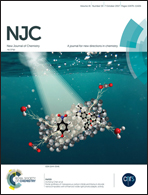Facile synthesis of mesoporous carbon nitride and titanium dioxide nanocomposites with enhanced visible light photocatalytic activity†
Abstract
A facile and efficient solution combustion method was developed and employed in the fabrication of novel mesoporous carbon nitride and titanium dioxide (C3N4–TiO2) nanocomposites as advanced photocatalysts for wastewater remediation. Urea was used as the precursor of C3N4, while titanium tetra-isopropoxide served as the source of titanium. Yellow nanocomposites were produced as compared to the formed white TiO2 and C3N4 nanomaterials. Transmission electron microscopic images and N2 adsorption/desorption analysis revealed that the fabricated nanocomposites possessed a mesoporous structure and much larger surface areas as compared to the individual constituents. X-ray photoelectron spectroscopic measurements and thermogravimetric analysis were utilized to determine the composition and thermal stability of the C3N4–TiO2 nanocomposites. Tauc plots derived from the UV-vis absorption spectra revealed that the formation of the C3N4–TiO2 nanocomposites significantly narrowed the band gap energy, leading to a high visible light response in contrast to the individual TiO2 (∼3.2 eV) and C3N4 (∼2.8 eV) samples. The optimal composition of the C3N4–TiO2 nanocomposites was determined, and the new nanocomposite developed in this study exhibited high visible light activity in the photochemical oxidation of Rhodamine B, as compared to the mechanically mixed C3N4 and TiO2 sample. This significant improvement in photocatalytic activity may be attributed to the synergistic effects of the red shift in absorption and the large surface area.



 Please wait while we load your content...
Please wait while we load your content...